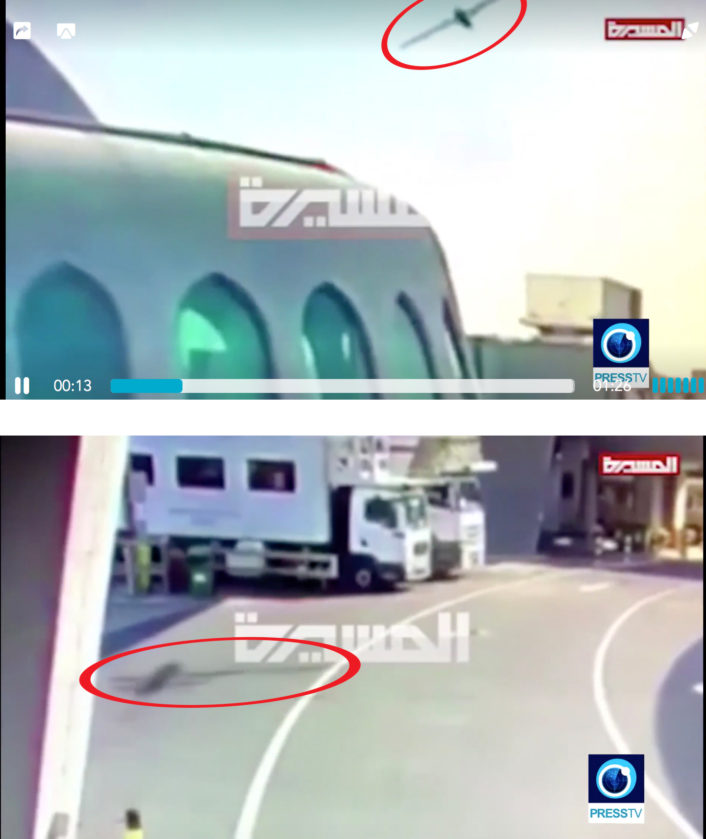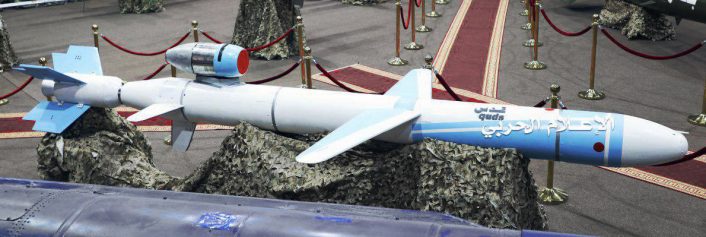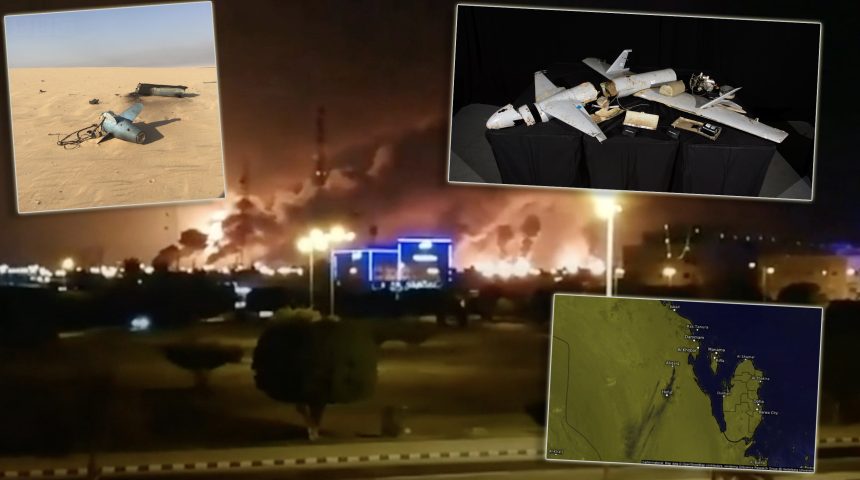Strike Has Strategic Implications, Amplifies Asymmetric Drone War Relevance.
Yemen’s Houthi “Ansar Allah” forces have claimed responsibility for two coordinated unmanned combat aerial vehicle (UCAV) attacks on Saudi Arabian oil facilities near the cities of Abqaiq and Khurais in Saudi Arabia, according to reports published on Saturday, September 14, 2019 by the Houthi-run Al-Masirah news agency and other international outlets.
The report comes as conflicting information about the source of the strikes was released at 20.26 (8:26 PM) local New York (0026 GMT) time.
A report in the credible U.S. news outlet The Wall Street Journal with a byline from journalists Summer Said, Jared Malsin and Jessica Donati claimed that:
“Secretary of State Mike Pompeo blamed Iran for coordinated strikes on the heart of Saudi Arabia’s oil industry, saying they marked an unprecedented attack on the world’s energy supply. The strikes shut down half of the kingdom’s crude production on Saturday, potentially roiling petroleum prices and demonstrating the power of Iran’s proxies. Iran-allied Houthi rebels in neighboring Yemen claimed credit for the attack, saying they sent 10 drones to strike at important facilities in Saudi Arabia’s oil-rich Eastern Province. But Mr. Pompeo said there was no evidence the strikes had come from Yemen.”
We call on all nations to publicly and unequivocally condemn Iran’s attacks. The United States will work with our partners and allies to ensure that energy markets remain well supplied and Iran is held accountable for its aggression
— Secretary Pompeo (@SecPompeo) September 14, 2019
Several credible sources including the BBC World News suggest the potential disruption could be as high as “5% of global production”. Saudi Energy Minister Prince Abdulaziz bin Salman released a statement that claimed, “5.7 million barrels a day of crude oil and gas production have been affected.”
Based on crude oil prices quoted on Saturday, September 14, 2019, the loss of production could be as much as $3.5 billion USD estimated from Saudi claims. If these figures are accurate, the strikes could represent a significant victory for Yemen’s Houthi rebels.

If claims of the source and effectiveness of the attacks are accurate they signal a new era in the asymmetrical use of small, unmanned combat aerial vehicles (UCAVs) commonly called “drones”.
Yemen has used drones for attacks on Saudi oil facilities before, but with no or limited effectiveness on targets. An earlier, Saturday, August 17, 2019 attack only 29 days ago on the Shaybah Oil Field approximately 40 kilometers (24.8 miles) from the northern boundary of the vast Saudi Empty Quarter, resulted in no injuries or reduction in Saudi oil production.
Interestingly, an AEW (Airborne Early Warning) aircraft could be observed after the attacks monitoring the airspace at the border With Iraq most probabky to detect other drones.
— Manu Gómez (@GDarkconrad) September 14, 2019
This graphic shows Saudi Air Defences around the Abqaiq oil facilities that were struck early Saturday. The drones were well within PAC-2 range, but outside Hawk range. It’s possible that the low-flying or the drones’ small size and composite materials helped it avoid detection. pic.twitter.com/AiMJ0LZT27
— Aᴍɪʀ (@AmirIGM) September 14, 2019
Forbes magazine senior contributor Ellen R. Wald wrote about the August 17, 2019 Houthi strike on Saudi’s Sahybah Oil Field:
“What is striking about the large number of attacks by the Houthis on Saudi infrastructure is that so many have been incompetent failures. Some of the failures are dur to rocket and drone defense systems deployed by Saudi Arabia. Yet, of those that hit their target, few have resulted in casualties of structural damage. It’s unclear if the attacks can even be said to terrorize Saudi Arabia, because it seems they have not altered Saudi actions or behavior.”
Houthi rebels claimed to have launched a drone attack on Abu Dhabi Airport back in July 2018 using three “Sammad-3” armed drones. At the time of that claimed attack, United Arab Emirates officials told media that the attacks did not occur. By contrast, Houthi sources told media outlets including Al Jazeera that the drones flew “1500 kilometers” before they reached Abu Dhabi’s airport. One truck was reportedly damaged in the incident but no injuries were reported.

Yemen’s Houthi rebels operate a number of different drone types. Their level of sophistication has increased over the last year. One type associated with Yemen’s Houthis is the Qasef-1 or “Striker-1” drone. A nearly identical variant of the Qasef-1 is fielded by Iran under the name, “Ababil-2” and “Ababil-3”. The Qasef-1 is a propeller powered “pusher” style UAV with operational radius reportedly limited to 100 kilometers (62 miles). Its primary role is stated as reconnaissance.
Yemen claimed that 10 drones were used in Saturday’s attacks on Abqaiq and Khurais in Saudi Arabia, but has not yet specified which type of drone they used in the attacks.
A report that surfaced on the ISW News Analysis Group only hours after Saturday’s attacks claimed that a new “Quds-1” jet-powered cruise missile was used in the two strikes on Saudi refineries.
Well well well… pic.twitter.com/bPgY6J67JE
— محمد بن خالد (@MbKS15) September 14, 2019
According to a report on the authoritative Janes.com from July 8, 2019:
“The Quds was also probably shorter, had a smaller solid-propellant booster and differently shaped wings and fins. The fins looked similar to one that was recovered from the missile that hit Abha airport and shown by Col Maliki during his 24 June briefing.
Col Maliki identified the engine on the cruise missile as a TJ100: a type of turbojet made by the PBS Group in the Czech Republic. The Quds cruise missile had an engine that looked similar to the TJ100 but which could be a copy. PBS told Jane’s that it has never exported engines to Iran or its allies and would co-operate with any investigation.
Ansar Allah also displayed two sizes of Sammad unmanned aerial vehicles (UAVs) that it has claimed to have used to attack targets in the United Arab Emirates (UAE) deep in Saudi Arabia. At least one of the two smaller ones was labelled as the Sammad-1 and both were equipped with electro-optical turrets for surveillance missions.
The two larger ones, at least one of which was labelled as a Sammad-3, did not appear to have surveillance payloads, but had bulges above the area where their wings join their fuselages, possibly to accommodate a larger explosives payload, as well as a fairing in front of their engines.”

Regardless of what specific cruise missile or UCAV the Yemeni Houthis used in Saturday’s attacks on Saudi refineries, the effectiveness of the strikes signals a new chapter in this conflict that now has truly global ramifications.









